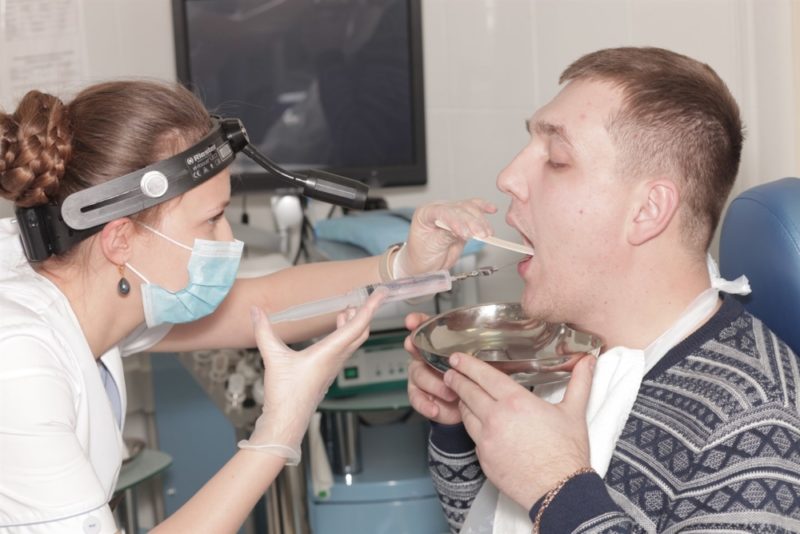A sore throat often accompanies ARVI and ARI. But in some cases, this is a sign of a beginning sore throat. If you do not conduct competent treatment of tonsillitis, it will go into a chronic form and will remind you of unpleasant symptoms at the slightest hypothermia or a drop in immunity.
Material Content:
Causes of tonsillitis
Tonsillitis can be of a viral or bacterial origin, and also be a consequence of an autoimmune disease. It is characterized by inflammation localized in the tonsils (palatines are more often affected). Pathology is associated with a decrease in immunity - both general and local.
Attention! The disease can occur against the background of hypothermia, stress or somatic pathology.
The acute form is called angina. Pathogens are usually caused by pathogens. Without competent and timely therapy, it flows into chronic tonsillitis. It can also provoke a focus of chronic infection in the oral cavity - carious teeth or periodontal pathology.
In some cases, chronic tonsillitis develops against the background of difficulty breathing through the nose. As a result of this, saliva, which has antibacterial properties, does not sufficiently wet the throat, and it remains without additional protection. This condition occurs due to hyperplasia of the nasal mucosa or curvature of its septum.
Classification of Infectious Disease
Tonsillitis is divided into acute and chronic. The first group includes primary and secondary.
Of those that are an independent disease, there are:
- catarrhal (the mildest course, characterized by hyperemia and slight edema);
- follicular (inflammation is localized in the follicles, purulent plugs appear);
- lacunar (a more extensive lesion of lymphoid tissue combined into lacunae);
- peptic ulcerous (the most dangerous form that can cause respiratory failure due to clogging of the respiratory tube with films).
The treatment of these forms is aimed at destroying the pathogen and restoring the functions of the tonsils.
Among the tonsillitis that occurs against the background of other diseases, they are distinguished:
- acute infectious (caused by scarlet fever, infectious mononucleosis, diphtheria, typhoid fever and tularemia);
- due to the pathology of the hematopoietic system (accompanied by leukemia, aleukia of an alimentary-toxic nature, the absence of granulocytes).
For successful treatment of these disease groups, primary pathology must be eliminated.
Chronic tonsillitis is also divided into several types:
- non-specific (may be in the stage of compensation or decompensation);
- specific - against the background of syphilis, scleroma, tuberculosis (have characteristic distinguishing features).
This classification of tonsillitis reflects the etiology of the disease, which means it helps in the selection of treatment. And sore throat is distinguished with the flow. Divided into light, medium and heavy. At the same time, systemic changes play a decisive role, while local ones only complement the picture.
Symptoms and signs in children and adults
Manifestations of the disease depend on its form and course. Acute tonsillitis in a child develops faster than in an adult, but has the same signs and symptoms. Catarrhal tonsillitis is characterized by redness of the tonsils, an increase in their size and pain when swallowing. A sharp increase in body temperature to febrile values is noted.
With follicular tonsillitis, yellowish dots appear on the tonsils, and regional lymph nodes increase in size. Purulent plugs are removed easily and painlessly. Upon transition to the lacunar type, the fever reaches 38-40 ° C, and plaque separation is difficult and is accompanied by unpleasant sensations. The oropharynx looks edematous, and the face turns red.
Transition to chronic tonsillitis in children is rare. This is due to the severity of symptoms in acute course and the attentive attitude of parents to the health of the child. Adults themselves often do not pay attention to pain for a long time and do not visit a doctor on time, so the disease can fade and recur for many years without treatment.
Chronic inflammation of the palatine tonsils has its own characteristic signs.
These include:
- yellowish plugs or purulent masses in the gaps of the glands;
- the presence of adhesions between the arches of the palate and tonsils;
- the lymphoid tissue on the glands is loose or dense due to the presence of scars;
- redness and swelling of the edges of the arches of the palate;
- inflammation of the regional lymph nodes.
Objective signs of chronic tonsillitis are accompanied by subjective sensations of pain during ingestion, especially after sleep, episodes of dry coughing, tickling or feeling of a lump in the throat, and a specific smell from the mouth. Sometimes discomfort passes to the neck, which is associated with lymphadenitis. The patient becomes irritable, gets tired faster, sweats profusely. Complaints can also be about low-grade fever in the evening, headaches and discomfort from the heart.
The diagnosis is made in the presence of two or more objective signs. In the stage of compensation, the disease is characterized only by local changes in the tonsils. When the condition worsens, frequent relapses occur, paratonsillar abscesses are frequent, and inflammation spreads to other organs.
Which doctor should I contact, diagnosis
If you have a sore throat, you should consult a general practitioner - a general practitioner or pediatrician. He will prescribe a general blood test and conduct an examination. If there are doubts in the diagnosis, it will give a direction to the ENT.
To clarify the causative agent, the contents of the gaps are taken for examination. In some cases, they make prints from the tonsils on a special glass to study the nature of the discharge. Pathogenic bacteria are found in it.
The blood picture corresponds to the etiology of the disease. With a bacterial infection, leukocytosis with a shift to the left is noted. If tonsillitis is caused by viruses, an increase in the number of lymphocytes is detected. Angina in children is also manifested by hypochromic anemia, an increase in the concentration of neutrophils, leuko- and monocytopenia, an acceleration of ESR, and pathological characteristics of serum (a drop in the titer of antibodies to streptococcus and the number of immunoglobulins, properdin, complement, etc.).
Chronic tonsillitis in the decompensation stage is characterized by an imbalance in B- and T-lymphocytes and their subspecies, the sensitivity of granulocytes to allergens secreted by bacteria, and the presence of immune complexes in the blood. To distinguish the disease from rheumatic heart disease, a phonocardiogram, an electrocardiogram are recorded, and nonspecific response factors and hemostasis are evaluated.
Methods for the treatment of acute and chronic disease
Treatment of angina in adults and children always begins with conservative methods. They may be general or local. The first type includes hardening, moderate sports loads, daily walks in the fresh air. But they can only be carried out at the stage of convalescence.
Local methods of exposure include drugs and physiotherapy. The latter include laser treatment of tonsillitis, short-wavelength UV irradiation, phonophoresis and diathermy. These methods are available in the acute period of the disease.
Drugs for inflammation of the tonsils
Antibiotics for the treatment of tonsillitis are prescribed only in the acute stage. The indication for their use is the preservation of temperatures above 38.5 ° C for 3 days. From angina, drugs from the group of aminopenicillins (Amoxiclav, Amoxicillin) are used. They are not destroyed by bacterial enzymes, which allows them to successfully perform their functions.
Local therapy consists in washing the gaps with silver preparations and disinfecting solutions (chlorhexidine, Miramistin). The procedure can be performed on an outpatient basis in a medical institution and at home. In clinics, a special apparatus is used for this, and for self-treatment, a syringe without a needle is used. The fluid is injected into the plugged holes, due to which the pathological secret is separated and goes out.
Another method of treatment is lubrication of the glands with iodine-containing agents (Lugol, 1.5% tincture, a mixture with glycerin). This helps relieve inflammation and speed healing. Methods of local therapy can be combined with each other to achieve a faster effect.
Folk remedies
Among folk recipes, rinsing with a mixture of soda, salt and iodine is considered the most effective. To do this, mix dry powders in equal proportions to 1 tbsp. l and add a couple of drops of iodine solution to 1 tbsp. boiled water. Gargle at least 1 time in 3-4 hours. In this way, chronic tonsillitis in the acute stage is treated. The course of therapy is 1-2 weeks until the symptoms disappear completely.
Surgical intervention
If conservative treatment does not give a positive result, tonsillectomy is performed. At the same time, doctors try to leave part of the lymphoid tissue, if there are healthy areas. This is necessary to ensure local immunity of the oropharynx. Otherwise, any ARVI will be accompanied by bronchitis and tracheitis instead of sore throat, as the infection will immediately go down to the lower respiratory tract.
Attention! Cryotherapy is considered a modern method of treating tonsillitis.
In this case, not only tonsils are treated with liquid nitrogen, but also the posterior surface of the oropharynx. As a result, the focus of infection is completely destroyed, which eliminates the recurrence of the disease. This method preserves the integrity of the tonsils, which ensures local immunity in acute respiratory infections and acute respiratory viral infections. Moreover, it is bloodless, which excludes the possibility of joining superinfection, and is practically painless.
Possible complications
If tonsillitis is not treated correctly and on time, complications join in.
These include:
- rheumatism;
- scleroderma;
- plexitis;
- nodular form of periarteritis;
- exudative polymorphic erythema;
- dermatomyositis;
- thyrotoxicosis;
- thrombocytopenic purpura;
- nephritis;
- myocardial inflammation;
- radiculitis;
- hemorrhagic vasculitis;
- noise in ears;
- vasomotor rhinitis;
- pathology of the vestibular apparatus;
- vegetovascular dystonia;
- myocardial dystrophy.
If there are suspicions of complications, it is necessary to visit the attending physician and undergo a full examination of the body. This will allow to identify pathological changes at an early stage and prevent their further development. To do this, patients should carefully monitor their health and timely contact specialists for medical help.
Prevention
Preventive measures include caring for the level of general immunity. To maintain it, hardening, regular preventive examinations and treatment of dental diseases and infections of ENT organs (otitis, sinusitis) are recommended. It is important to monitor the cleanliness of the room at home and at work, follow the principles of good nutrition and observe the daily routine.
If the patient is diagnosed with chronic tonsillitis, he is put on a dispensary account in the clinic. Such patients are required to visit an ENT doctor every 3 months during the year after an extreme exacerbation. If remission is maintained during this period, examinations are carried out once every six months.
Important! After 3 years without exacerbations, the patient is deregistered for the disease.
If after 6 courses of treatment the patient has symptoms of tonsillitis, he is referred for surgical treatment. Six months after the operation, dispensary observation is stopped.
Tonsillitis is not considered a dangerous disease. But its complications can create life-threatening conditions. Therefore, it is important to identify and begin to treat this pathology in time. In this case, it is likely to permanently get rid of the disease without consequences.





















